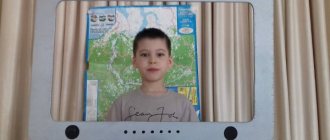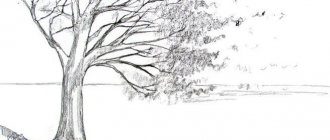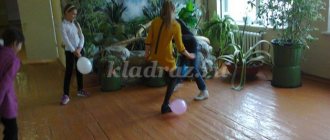Last name, first name _______ Date of birth ______ General physical development _____ Health status _____ Family composition _____
This is also important to know: What is a deposit, what is it for and how to arrange its transfer
Entered preschool educational institution____
She has been attending kindergarten since August 20__. I quickly adapted to kindergarten.
A child from a complete family. Relationships with parents are built on a warm, friendly basis. In a family, the child communicates most with his mother. At home he prefers to draw, play checkers, draw, and lego. He readily responds to his mother’s offers to help with cleaning the house. Places toys independently.
Somatic health. She rarely gets sick, has a good appetite, falls asleep quickly, and has a restful sleep.
Social skills are age appropriate. The child can independently use toiletries, wash his face, wash his hands, comb his hair, can dress, undress, put on his shoes, and use a spoon independently. The boy is aware of his physical capabilities. Aware of himself in time and space.
Features of gaming activity: the child prefers subject-based procedural and active games, participates in role-playing games, performing different roles in them. He loves to play outdoor games and cars with other children. He enjoys playing with Legos and loves listening to fairy tales.
The main difficulties noted in communication: The child has developed a friendly attitude towards children and has developed a desire to cooperate with them. Among the guys in the group there is a constant circle of friends with common interests. Willingly makes contact with adults.
Features of individual cognitive processes: The child is distinguished by a high level of development of attention, auditory and visual memory, and imagination. Visual-figurative and elements of logical thinking are quite well developed.
Speech development: The child has good speech development. Pronounces all phonemes, knows how to identify phonemes in a word. The child has a large vocabulary. Builds sentences correctly. Monologue speech predominates: correctly constructs oral messages and reasoning about ways to perform actions.
The main difficulties noted in training: The child easily masters the program; the pace of work during classes is uniform. Shows interest in activities. He enjoys his work and feels confident there. He reacts negatively to criticism, may become offended and stop completing the task. Loves praise and approval, which he tries to earn. The child's level of moral development is normal. The boy knows what is good and what is bad.
Loves to be in kindergarten. The cognitive type of communication with the teacher predominates. He understands that in kindergarten he is taught to read, draw, speak English, and dance. This is precisely why he loves his teacher.
Character traits. The boy is sociable, affectionate, friendly, touchy.
Psychologist of preschool educational institution No.___: __________________
Head of preschool institution No.___: ___________________
Psychological and pedagogical characteristics for a preschool educational institution graduate for admission to school
1st option
Full name, date of birth, address ______________
Pupils of preschool educational institution No. _______, group No. ________
Date of admission to preschool educational institution ______________
1. Information about the family: mother’s full name, year of birth, place of work; Father's full name, year of birth, place of work; conditions of education. The family is complete, incomplete, conditions are satisfactory or not, indicate the reasons for unsatisfactory conditions.
2. The stock of information about the environment ______________
3. Characteristics of cognitive processes: attention (ratio of voluntary and involuntary, concentration); memory; thinking (features of analysis, synthesis, generalization, classification, establishment of cause-and-effect relationships); sensory development (properties of objects, time orientation); speech (dictionary, grammatical structure of speech, sound pronunciation); sound-letter analysis.
4. Development of elementary mathematical concepts
5. Features of motor development (gross and fine motor skills, leading hand, presence of motor disinhibition, state of constructive and graphic skills).
6. Formation of motivation for educational activities
7. Emotional-volitional sphere and individual psychological characteristics of the child.
8. Recommendations ______________
2nd option
1. General information about the child: full name, date of birth, home address, since when he has been attending the preschool educational institution.
2. Family characteristics: parents’ full names, year of birth, place of work; family composition: complete, single-parent, large, presence of brothers and sisters; who is raising the child (mother, father, grandmother, others); whether sufficient attention is paid in the family to the upbringing and education of the child.
3. Typological features: active, mobile, sluggish, inert, slow; excitable, unbalanced, calm, balanced, inhibited, whiny; speed of reaction to verbal stimuli, switchability; the prevailing mood is cheerful, depressed, without any special shade. Do you experience sudden mood swings throughout the day? whether he persists in the face of difficulties or retreats in the face of them; whether he asks for help and uses it.
This is also important to know:
How to file a claim for non-compliance with the terms of the contract and why it is needed
4. Characteristic features: sociability, isolation (easily makes contact, perceives the situation correctly, understands its meaning, behaves adequately, contact and communication are difficult, understanding and responding to the situation is not always or not entirely adequate, does not make contact well, has difficulty in communication, understanding the situation); attitude towards comrades (friendliness, negativism, kindness, rudeness, etc.); attitude towards leadership (desire for primacy, whether others recognize him as a leader, whether he shows organizational skills and initiative); attitude towards adults; attitude towards assignments, rewards, reprimands; what types of activities does he prefer; activity of verbal communication (corresponds to age, increased, decreased, isolation noted, negative attitude towards verbal communication); behavior (organized, sometimes does not regulate one’s behavior, constant external control is required).
5. Psychological characteristics: auditory memorization, visual memorization, tactile memorization (memorizes quickly or slowly, with difficulty, transition to long-term memory, RAM capacity: sufficient, limited, low); stability of attention (capable of long-term concentration or easily distracted); nature of distraction (distracted by stimuli, in the absence of external stimuli); switchability of attention (easy, fast, slow, difficult); distribution of attention (sufficient, difficult); general level of attention development (age-appropriate, low, unformed).
6. Level of development of mental activity: the ability to compare, classify, generalize, the ability to identify an essential feature of objects and phenomena; the ability to use techniques for memorization (mediation, grouping, associations).
7. Development of sensory functions: the state of the analyzers, the presence of generalizing ideas about shape, size, color - the concept of relativity - corresponds to age, unformed, impaired.
8. Development of imagination: brightness, liveliness, richness of imagination, ability to operate with images, in what types of activities it manifests itself (music, arts, mathematics, physical education, speech, design, etc.), age-appropriate, excessive, weakness of imagination processes.
9. Verbal part: understanding stories with hidden meanings; paired analogies; plot storytelling - nominative and communicative functions of speech; ability to maintain dialogue; speech activity is adequate to the situation and age, excessive, difficulties in initiating a speech utterance, emotional inadequacy, problems with expanded speech, difficulties in sound pronunciation, the presence of stuttering, echolalia, speech cliches, etc.
10. Performance in the classroom: active, interested, indifferent attitude; concentrated or often distracted during classes; quickly or slowly starts working; pace of work: fast, medium, slow; reasons for the slow pace of work: thinking, careful execution, decreased mental activity (lethargy, lethargy, distractibility, etc.); fatigue manifests itself in a slowdown in pace, deterioration in quality, or complete cessation of work; subjective and objective I admit! fatigue (complaints of fatigue, headache, lethargy, drowsiness, distractibility, etc.); decline in performance (in the middle of the lesson, at the end of the lesson); ability to follow instructions, ability to retain instructions for duration.
11. Arbitrariness of activity: holds the goal of the activity, outlines its plan, selects adequate means, checks the result, brings the work started to completion; often gets distracted during activities, overcomes difficulties only with psychological support, needs frequent encouragement; the activity is chaotic, ill-conceived, individual conditions of the task are lost, the result is not checked, the activity is interrupted due to difficulties, assistance is ineffective.
12. Work carried out with the child: whether developmental, correctional, accompanying work was carried out for how long, type (on the formation of spatial concepts, development of cognitive processes, emotional education, etc.); recommendations for further work; results, success, skill formation (by age, with difficulty, delayed); work with parents, family (parental attitude, success, systematicity, etc.).
* * *
And in conclusion, we bring to your attention “Portrait of a kindergarten graduate,” which can serve as a guide in determining the normal development of a child upon graduation from kindergarten and drawing up a psychological and pedagogical profile.
Characteristics of the child
Now that you have an idea of what a teacher’s correct characteristics for a child should look like, it is important to understand what algorithm it is based on. We have developed an approximate diagram:
- The very first item you need to indicate is information about the child. These are his initials, date, main place of birth. The child’s place of residence and his registration address are indicated. The language of child upbringing is established, which is used both in kindergarten and at home. It is indicated how long the child attends kindergarten and with what frequency.
- The teacher should describe how much the child enjoys visiting this institution. Here you need to indicate how often classes were missed and what the main reason was. Also, if a child has chronic diseases, due to which he often does not appear in the institution, this should be noted.
- Without fail, the teacher's description of a kindergarten student contains an indication of how the child interacts with other students, including adults, teachers, nannies, and so on. How sociable and independent the child is in principle. The teacher indicates to what extent the child follows the rules of personal hygiene, as well as how independent he is in terms of dressing, falling asleep, and eating.
- They indicate interests in specific activities, for example, games, drawing, music, and so on.
- Without fail, the teacher must clarify how the child feels about work. Can he clean up the toys from start to finish? From the first time he fulfills the teacher’s request. Does he have the motivation to help his older peers?
- The position the baby takes during games is indicated. What roles are most often his favorites, how can he regulate critical situations that arise.
- In the very last point, the teacher takes responsibility for giving the child a psychological characteristics, taking into account the characteristics of his behavior, as well as relationships with parents, educators and peers.
Play activity
The description necessarily includes a very important point - gaming activity, since the child spends most of his time playing games of different types. This describes the child’s inclinations, as well as his interests aimed at this or that pastime.
This is also important to know:
Characteristics of the student, ready-made samples and rules for compiling
It is also imperative to take into account the specific type of activity when the child is most enthusiastic and shows himself actively in the gameplay. This also includes creative activities that captivate the child.
Emotional-volitional sphere
These points describe the mood of the child, including a child with mental retardation, which is typical for him in most situations. It also indicates the adequacy of the baby and his reaction to simple external stimuli, for example, a request to put away toys or go to bed.
The child’s purposefulness and strong-willed character are characterized, that is, the teacher makes a conclusion about whether the child can control his activities and actions or not.
There are negative aspects to the character of many children. Among them are theft, deceit, sneaking, and so on. As unpleasant as it may be, the characteristics even indicate such nuances.
Organizational aspects
The document is prepared with the participation of a psychologist, speech therapist and teacher. A ready-made description of a kindergarten student is provided for:
Free legal consultation
We will answer your question in 5 minutes!
Free legal consultation We will answer your question in 5 minutes!
Call: 8 800 511-39-66
Ask a Question
- Admission to school.
- Solutions to legal issues.
- Consultations with a psychiatrist.
- Commissions for transfer to a speech therapy group or specialized educational institution.
- Children with disabilities who attend kindergarten.
- Guardianship and trusteeship authorities.
This is also important to know:
How to make a claim under a contract for the sale of goods
The pedagogical characteristics of a preschool educational institution student is an official document that is invalid without the signature of all persons filling out the form. The seal and signature of the head of the institution is also required.
Characteristics of a kindergarten graduate
In such a document, it is very important to pay attention to motivation for learning and the knowledge gained. It is on the basis of this document that it will be easier for future teachers to navigate the successes of a pupil of a preschool educational institution or a group of a preschool department of a gymnasium.
- Personal data in the form of initials, address and birth information.
- Information about the number of the kindergarten and group.
- Duration of kindergarten attendance.
- Information about the child’s family, the presence of brothers and sisters is indicated.
- The initials of the parents and their places of work are indicated.
- If the family is single-parent, you need to indicate with whom the child mostly lives at the moment.
- If the family is low-income, this should also be noted.
- It is indicated how the child reacted to entering kindergarten.
- The baby's attention is described, as well as the characteristics of memory and thinking.
- The teacher focuses on describing sensory development, speech and analysis of sounds.
- Information about the child's mathematical development is provided.
- Attention is paid to motor skills, how developed they are. Which hand is the dominant one, how much the child can draw, sculpt, and so on.
- The presence or absence of motivation for educational activities is noted.
- The emotional background of the baby is indicated, as well as the psychological characteristics of a particular child.
- In the last paragraph, the teacher must give his recommendations for subsequent teaching in the first grade.
Second version of the characteristics
- General information about the child is indicated, starting with initials and ending with place of residence.
- The family is characterized. Information about parents and their places of work, family composition, and the presence of children in the form of brothers and sisters is indicated here. It is indicated who most often takes part in raising the child, and how much attention he gets from his parents.
- The child's character traits are indicated. Mobility, presence of whims, pathogens, calmness, speed of reaction, and so on are indicated. It also characterizes how cheerful, cheerful and healthy the child is.
- It describes the open or closed style of sociability, how the baby makes contact, and how adequately he reacts to current situations.
- The peculiarity of the child’s behavior in the team is indicated.
- Psychological characteristics are established. For example, the presence of auditory and visual or visual memory, tactile sensation, the presence or absence of long-term memory, working memory, and so on. Particular attention is paid to the stability of attention.
- The level of development of the thought process is indicated. How much a child can qualify the information received, generalize it, and also use it for memorization.
- The possibility of using touch functions is indicated.
- It indicates how much a child can develop his imagination. Here, attention is mainly paid to the richness of imagination, as well as the ability to present various images.
- It is indicated how the child reacts to reading fairy tales and stories, how much he can retell what he has read, and ask questions.
- It is indicated if the child has speech defects, for example, choking, speech stamps, difficulties in pronouncing certain sounds.
- It is indicated how efficient the child is during classes according to a given program. How quickly or slowly he completes the task, is he motivated.
- The performance of the activity is established. Its goal, plan, and how purposeful the child is in general are indicated.
- It is indicated what work was done with the child, whether there was any correction, as well as containment of emotional outbursts.
- How parents influenced the child's ability to learn.
- In conclusion, the teacher makes a conclusion about what approach to apply to the child when he enters first grade.
Speech therapy presentation for a preschooler for PMPK
Speech therapy presentation for PMPC
for a pupil of MBDOU "Kindergarten No. 11" in Kudymkar
(FULL NAME.), …. b.b.
Daria Kh. attends the senior group of MBDOU “Kindergarten No. 11”. She has been studying individually at the preschool speech center since January 2020. Early correctional work with the girl was difficult due to prolonged non-attendance at the preschool educational institution for various reasons.
Physical development by age. Hearing and vision are normal. The history of early speech development shows a severe delay: the appearance of the first words (“mom”, “dad”) - by 3 years; simple phrase - by 5.5 years.
The speech environment and social conditions are unfavorable. The family is large and complete (stepfather). The mother is indifferent to her daughter’s speech problems and does not pay enough attention to the child’s development. All family members are Russian-speaking.
Dasha is accessible to contacts, but her need for communication is weakly expressed. Lack of desire to communicate is associated with speech difficulties. The communicative function of speech is impaired, speech consists of individual words and onomatopoeia. Instead of missing speech, he uses gestures, facial expressions, and intonation.
The anatomical structure of the organs of the articulatory apparatus without anomalies. There are features of articulatory motor skills when performing motor tests by demonstration: the tone of the tongue is tense, the range of movements is incomplete, the transition from one movement to another is blurred. Severe hyperkinesis and salivation are not observed. The voice is ringing and intonationally expressive.
Fine motor skills are not well developed. Head performs tests selectively, his hand movements are inaccurate. Muscle tone is increased. The leading hand is the right. Holds the pencil incorrectly, the pressure is strong. Cutting with scissors is difficult. General motor skills are slightly impaired.
Speech perception and understanding are not impaired. He picks up the intonation of others well.
Dasha's own speech can be characterized as the absence of commonly used speech. The system of language means is not formed, there is underdevelopment of expressive speech, impressive speech is more developed. Speech underdevelopment is systemic.
The vocabulary is limited to everyday topics and is qualitatively inferior. The active vocabulary is significantly smaller than the passive one - these are several understandable, often used words by the girl, simple in syllable composition (“yes”, “give”, “home”, “mom”, “bye”, “there”, “Dasha”). At the request of an adult, the child tries to name the object, but the result is a sound complex of 2-4 sounds. It is impossible to repeat a reflected or conjugated word. Pronouncing a word syllable by syllable is difficult; multiple repetitions of each syllable are required. Often, instead of words-objects, he uses onomatopoeia (“yum-yum” - all products, “mu” - cow, sheep, ram, “bi-bi” - various ground transport, “mammies” - flowers, etc.). A high-quality dictionary is characterized by the absence of adjectives that describe color (indicates an object of a similar color), shape (draws with a finger), and size of objects (there are “big” and “small”). The verb dictionary is characterized by insufficiently formed ideas about the actions being performed and their differentiation. A narrowing of the meanings of words is revealed.
Violation of the sound side of speech is manifested in unstable pronunciation of hissing sounds and the absence of sounds [p]. [R']. [l]. The syllable structure is grossly disrupted. Words consisting of 1 syllable and words of 2 open syllables are available for pronunciation independently and after an adult. Phonemic hearing functions are unformed. Does not differentiate between voiced and deaf. Phonemic perception at the stage of initial formation: correctly identifies the initial vowel sound in a word.
Word change is difficult. Does not know how to use word formation tools. Understands, but does not use prepositions in speech. Uses a simple two-word sentence (“Is this here?” “Auntie, bye”, “I’m busy”, “Let’s (go) there?”). All types of coherent speech are unformed.
In a familiar environment, Dasha’s speech activity is increased: she tries to speak using facial expressions, gestures, voice and intonation. Cognitive activity is reduced. The girl's behavior in classes and in free activities is calm, with occasional fussiness and motor restlessness. She often plays alone. Self-control skills are poorly developed.
During three months of correctional and speech therapy work with the girl, the disorder was not eliminated, but slight positive dynamics were observed.
Speech therapy classes are aimed at developing the motivational basis of speech activity and independent speech. During the classes, correctional work is carried out at the lexical level, work on the syllable structure of the word. Correction of sounds is carried out in parallel.
Speech therapy conclusion:
OHP (I – II level).
Recommendations:
determination of further educational route.
04/30/2019 Teacher-speech therapist_______/________
Head of MBDOU "Kindergarten No. 11"________ /_______
How to help a mentally retarded child master speech
A speech therapy program for children with mental retardation according to the Federal State Educational Standard is specially developed after diagnosis by the teaching staff. The research results are displayed immediately after the examination.
Work program on speech therapy for mentally retarded children according to the Federal State Educational Standard
For each unpronounceable sound, a program should be developed in which children can improve their speech skills. Lessons in non-verbal and partially verbal communication will allow the preschooler to restore the articulatory apparatus.
Independent speech skills
The first and second stages of the program involve diagnosing and preparing children for classes. Fine motor skills, speech, attention, and thinking also develop here. The lack of development of one element in the process suspends the normal development of speech.
Third stage. Sounds are corrected, phonemic hearing develops, vocabulary expands, and correct speech is built on the basis of lexical and grammatical definitions.
Fourth stage. After the course of the speech therapy program, an assessment is given and the result is compared with the initial lesson.






